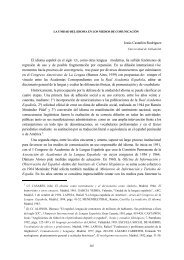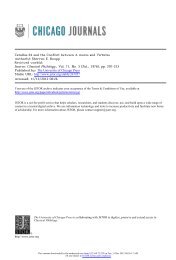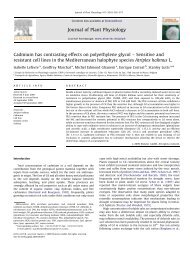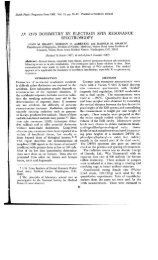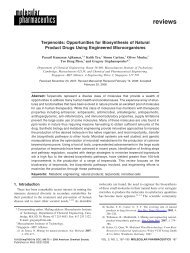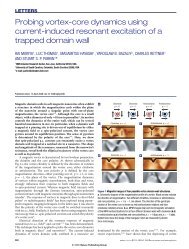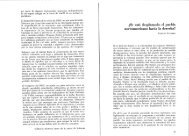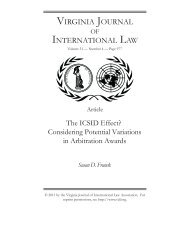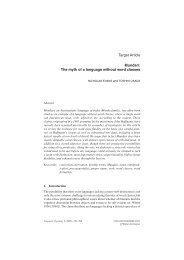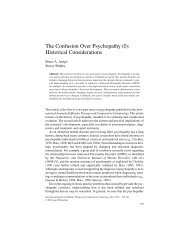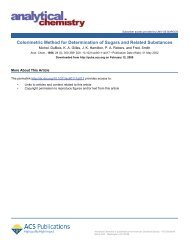Volatile composition of oak and chestnut woods used in brandy ...
Volatile composition of oak and chestnut woods used in brandy ...
Volatile composition of oak and chestnut woods used in brandy ...
You also want an ePaper? Increase the reach of your titles
YUMPU automatically turns print PDFs into web optimized ePapers that Google loves.
206 I. Caldeira et al. / Journal <strong>of</strong> Food Eng<strong>in</strong>eer<strong>in</strong>g 76 (2006) 202–211<br />
Table 2<br />
Contents <strong>of</strong> volatile compounds <strong>in</strong> aqueous alcoholic wood extracts (unheated <strong>and</strong> heated <strong>woods</strong>) <strong>and</strong> wood orig<strong>in</strong> effect (results expressed as lg per<br />
g <strong>of</strong> dry wood)<br />
Compound Wood orig<strong>in</strong> effect CNE CNF CNG CAST CFA CFL CAM<br />
Acetic acid ** x 31.23a 63.46cd 77.26d 34.33a 52.16bc 45.67ab 42.51ab<br />
SD 13.55 23.76 22.73 16.79 15.63 21.09 22.17<br />
Furfural n.s. x 105.53 78.99 138.33 86.38 92.85 83.58 92.85<br />
SD 157.07 56.70 140.92 113.73 50.96 45.81 80.32<br />
5-Methyl-furfural n.s. x 10.40 9.63 16.80 11.04 10.70 14.14 15.39<br />
SD 17.03 9.87 20.64 13.63 8.14 8.67 15.38<br />
4-Hydroxy-2-butenoic acid lactone ** x 0.59a 1.05ab 1.84c 1.37bc 1.48bc 1.53bc 1.61c<br />
SD 1.03 0.57 1.43 1.02 0.34 1.22 0.86<br />
HMF ** x 13.15a 23.53bc 26.42c 16.60ab 13.22a 23.06bc 13.63a<br />
SD 14.92 23.90 26.26 16.03 12.31 21.15 14.09<br />
Propanoic acid * x 0.37a 0.44a 0.99b 0.40a 0.53a 0.67ab 0.57a<br />
SD 0.63 0.39 0.58 0.33 0.40 0.54 0.53<br />
Hexanoic acid ** x 1.21a 4.13b 3.43b 3.75b 4.95bc 1.55a 6.43c<br />
SD 0.40 3.28 2.50 2.21 3.16 0.75 4.99<br />
trans-b-Methyl-c-octalactone ** x 3.07bc 2.95bc 3.10bc 0.66a 1.60ab 5.63d 4.26cd<br />
SD 0.88 0.94 1.93 0.31 0.95 3.07 1.04<br />
cis-b-Methyl-c-octalactone + 4-methyl-guaiacol ** x 9.15bc 11.24c 8.80bc 0.88a 4.50ab 17.99d 46.59e<br />
SD 4.54 6.93 4.71 0.72 2.38 13.06 9.43<br />
Octanoic acid n.s. x 2.02 2.53 2.10 2.61 2.87 1.77 2.48<br />
SD 1.83 2.49 0.81 1.24 2.07 1.14 1.47<br />
Decanoic acid n.s. x 2.31 2.19 1.31 1.26 1.13 2.17 1.02<br />
SD 0.80 3.39 1.00 0.40 0.49 1.06 0.31<br />
Dodecanoic acid n.s. x 3.01 3.82 2.26 1.60 1.64 3.34 3.77<br />
SD 2.12 4.56 1.34 0.77 1.10 1.81 2.13<br />
Guaiacol ** x 1.59c 0.77a 1.00ab 0.93ab 1.07abc 0.62a 1.43bc<br />
SD 0.25 0.45 0.45 0.26 0.35 0.13 0.02<br />
Eugenol ** x 1.74ab 2.82d 1.86abc 2.11bcd 1.22a 2.65cd 4.55d<br />
SD 0.86 1.34 1.11 1.14 0.36 1.73 0.47<br />
Syr<strong>in</strong>gol n.s. x 0.86 1.38 1.37 0.91 0.79 2.05 1.44<br />
SD 1.81 2.11 2.47 0.91 1.02 2.21 2.42<br />
4-Allyl-syr<strong>in</strong>gol n.s. x 1.30 2.13 1.85 2.72 2.87 2.99 3.26<br />
SD 1.25 1.61 1.79 1.09 4.34 2.13 1.67<br />
Vanill<strong>in</strong> ** x 15.10a 18.86ab 21.13ab 24.70bc 24.17b 32.82c 22.56ab<br />
SD 11.62 15.38 16.95 20.34 18.17 26.91 18.92<br />
Acetovanillone * x 0.47a 1.93abc 1.59ab 2.60bc 1.60ab 3.63c 1.37ab<br />
SD 1.05 4.02 2.56 2.01 1.25 2.71 1.08<br />
x, means <strong>of</strong> eight values; SD, st<strong>and</strong>ard deviation; means followed by the same letter <strong>in</strong> a row are not significantly different at the 0.05*, 0.01** or<br />
0.001*** level <strong>of</strong> significance; n.s. without significant difference.<br />
When the analysis was performed with all the different<br />
types <strong>of</strong> wood samples (Table 2) it was detected a<br />
wood orig<strong>in</strong> effect on the same variables, namely acetic<br />
acid, 4-hydroxy-2-butenoic acid lactone, hexanoic acid,<br />
trans-b-methyl-c-octalactone, cis-b-methyl-c-octalactone<br />
+ 4-methyl-guaiacol, guaiacol, eugenol, <strong>and</strong> vanill<strong>in</strong><br />
with exception for the furfural, HMF, propanoic<br />
acid <strong>and</strong> acetovanillone levels. However the results <strong>of</strong><br />
unheated wood discrim<strong>in</strong>ation, based on the majority<br />
<strong>of</strong> analysed compounds, were quite different from those<br />
obta<strong>in</strong>ed with all the different types <strong>of</strong> wood.<br />
Only for the amounts <strong>of</strong> hexanoic acid, trans-b-methylc-octalactone,<br />
cis-b-methyl-c-octalactone <strong>and</strong> eugenol,<br />
the wood discrim<strong>in</strong>ation was similar on both analyses.<br />
The two isomers <strong>of</strong> b-methyl-c-octalactone, which<br />
have high sensory impact (Abbott, Puech, Bayonove,<br />
& Baumes, 1995; Boidron, Chatonnet, & Pons, 1988),<br />
allow to dist<strong>in</strong>guish between French <strong>and</strong> American<br />
<strong>oak</strong> extracts <strong>and</strong> their related aged beverages (Guichard,<br />
Fournier, Masson, & Puech, 1995; Guymon & Crowell,<br />
1972; Onishi, Guymon, & Crowell, 1977). In this work,<br />
we found a significant effect <strong>of</strong> wood orig<strong>in</strong> on trans <strong>and</strong><br />
cis isomer amounts <strong>in</strong> unheated <strong>woods</strong> (Table 1). Concern<strong>in</strong>g<br />
the Portuguese <strong>chestnut</strong> wood, it is remarkable<br />
that it has a significant low level <strong>of</strong> these two isomers.<br />
In fact, <strong>in</strong> a previous work on the <strong>chestnut</strong> volatile evaluation,<br />
the b-methyl-c-octalactone isomers were not<br />
found (Clímaco & Borralho, 1996). On the contrary to<br />
other results (Masson et al., 1995; Mosedale & Savill,<br />
1996) we found that CFL wood has higher amount <strong>of</strong><br />
trans isomer than CFA wood (Tables 1 <strong>and</strong> 2).<br />
It was verified that cis-b-methyl-c-octalactone contents,<br />
permits the formation <strong>of</strong> two groups, one constituted<br />
by the CAM with the highest amounts <strong>of</strong> this<br />
compound, <strong>and</strong> another with all the other types <strong>of</strong> wood.<br />
These results are <strong>in</strong> agreement with other authors



